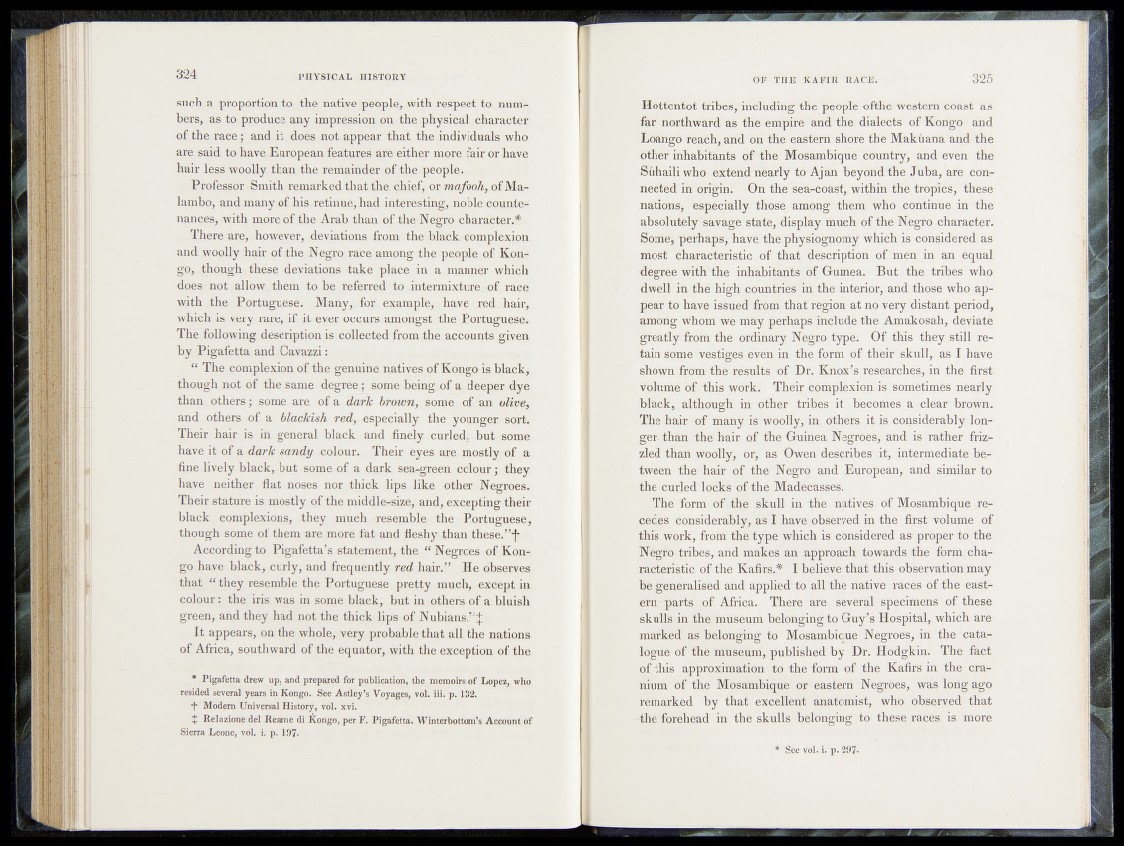
such a proportion to the native people, with respect to numbers,
as to produce any impression on the physical character
of the race; and it does not appear that the individuals who
are said to have European features are either more fair or have
hair legs woolly than the remainder of the people,
Professor Smith remarked that the chief, or mafooh, of Ma-
lambo, and many of his retinue, had interesting, noble countenances,
with more of the Arab than of the Negro character.*
There are, however, deviations from the black complexion
and woolly hair of the Negro race among the people of Kongo,
though - these deviations take place in a manner which
does- not allow them to be referred to intermixture of race
with the Portuguese. Many, for example, have red hair,
which is very rare, if it ever occurs amongst the Portuguese.
The following description is collected from the accounts given
by Pigafetta and Cavazzi:
“ The complexion of the genuine natives of Kongo is black*
though not of the same degree; some being of a deeper dye
than others; some are of a dark brown, some, of an olive,
and others of a blackish red, especially the younger sorfc
Their hair is in general black and finely curled, but some
have it of a dark sandy -colour. Their eyes are mostly of a
fine lively black, but some of a dark sea-green colour; they
have neither flat noses nor thick lips like other Negroes:
Their stature is mostly of the middle-size, and, excepting their
black complexions, they much resemble the Portuguese,
though some of them are more fat and fleshy than these.”-j*
According to Pigafetta’s statement, the “ Negroes of Kongo
have black, curly, and frequently red hair.” He observes
that "they resemble the Portuguese pretty much, except in
colour: the iris was in some black, but in others of a bluish
green, and they had not the thick lips of Nubians.’' J
It appears, on the whole, very probable that all the nations
of Africa, southward of the equator, with the exception of the
• Pigafetta drew up, and prepared for publication, the memoirs of Lopez, who
resided several years in Kongo. See Astley’s Voyages, vol. lii. p. 132.
Modem Universal History, vol. xvi.
+ Relaziotre del Reame di Kongo, per F. Pigafetta. Winterbottom’s Account of
Sierra Leone, vol. i. p. 197.
Hottentot tribes, including'tfié’^eople ofthe western coast as
far northward as the ^empire and the dialects of Kongo and
Loango reach, and on the eastern shore the Makhana and the
other inhabitants of Mosambique ’country, and even the
Suhaili who è$tend nearly to Ajan bfeyohd the Juba, are connected
in origin. On the seLa-coalst, within the tropics, these
nations, especially those among thèmywho continue in the
absolutely'savage state,;displ&y much of the Negro character.
Some, perhaps, have the physiognomy which is considered, as
most characteristic of that description df «^eh^irt!an equal
.■degree with the inhabitants^ q£ Guinea. But ttó t‘iribes who
dwell in the high countries' in theJinterior, ■ and' those \yhd appear
to have issued from thats rbgfpji a|m>^ery distant period,
among whom we may'pfehaps include the Amakèsah, deviate
greatly from the ordinary ilmiHH type. Of this they still retain
some vestiges eVen in the form of their skull, as I have
shown from the results of Dr. Kno|f.*s.‘resqarches, in the first
volume of this work. Their complexion ^Sometimes nearly
black, although in other-tribes it becomes a^clear brown.
The hair of many is woolly, in others ifcKi|| considerably Iqd-
ger-than the hair of the Guinea Negi^^'jipd is rather friz-'
zled than woolly, Or, as Owen descnlgtö^ intermediate be.-
tween the hair of the Negro and European, and similar to
the cuxled locks of the Madecasses.
The form of the skull in the natives of Mosambique recedes
considerably,, as I haye; observed in ?the first volume of
this work, from* the type which is considered as proper to the
Negro tribes, and makes an approach towards the form characteristic
of the Kafirs.* I believe that this observation may
be generalised and applied to all the native ra^es of the eastern'parts
.of Africa. There are several;specimens of these
skulls in the museum belonging to Guy’s Hospital, which are
marked as belonging to Mosambique-; Naroes, in the catalogue
of the museum, published by Dr. Hodgkin. The fact
of this approximation to the form of the Kafirs in the cranium
of the Mosambique or eastern Negroes, was long ago
remarked by that excellent anatomist, who observed that
the forehead in the skulls belonging to these races is more
* Sée Vól.' i. p. 297*
■ H h M m m h b h m h h h h ■ ■ ■ ■